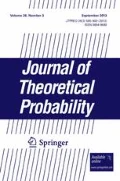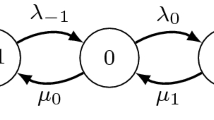Abstract
A well-known theorem usually attributed to Keilson states that, for an irreducible continuous-time birth-and-death chain on the nonnegative integers and any d, the passage time from state 0 to state d is distributed as a sum of d independent exponential random variables. Until now, no probabilistic proof of the theorem has been known. In this paper we use the theory of strong stationary duality to give a stochastic proof of a similar result for discrete-time birth-and-death chains and geometric random variables, and the continuous-time result (which can also be given a direct stochastic proof) then follows immediately. In both cases we link the parameters of the distributions to eigenvalue information about the chain. We also discuss how the continuous-time result leads to a proof of the Ray–Knight theorem.
Intimately related to the passage-time theorem is a theorem of Fill that any fastest strong stationary time T for an ergodic birth-and-death chain on {0,…,d} in continuous time with generator G, started in state 0, is distributed as a sum of d independent exponential random variables whose rate parameters are the nonzero eigenvalues of −G. Our approach yields the first (sample-path) construction of such a T for which individual such exponentials summing to T can be explicitly identified.
Similar content being viewed by others
References
Aldous, D., Diaconis, P.: Strong uniform times and finite random walks. Adv. Appl. Math. 8, 69–97 (1987)
Brown, M., Shao, Y.S.: Identifying coefficients in the spectral representation for first passage time distributions. Probab. Eng. Inform. Sci. 1, 69–74 (1987)
Cox, J.T., Roesler, U.: A duality relation for entrance and exit laws for Markov monotone Markov processes. Ann. Probab. 13, 558–565 (1985)
Diaconis, P., Fill, J.: Strong stationary times via a new form of duality. Ann. Probab. 18, 1483–1522 (1990)
Diaconis, P., Miclo, L.: On times to quasi-stationarity for birth and death processes. J. Theor. Probab. (2009). doi:10.1007/s10959-009-0234-6
Diaconis, P., Saloff-Coste, L.: Separation cut-offs for birth and death chains. Ann. Appl. Probab. 16, 2098–2122 (2006)
Fill, J.A.: Strong stationary duality for continuous-time Markov chains. Part I: Theory. J. Theor. Probab. 5, 45–70 (1992)
Fill, J.A.: An interruptible algorithm for perfect sampling via Markov chains. Ann. Appl. Probab. 8, 131–162 (1998)
Fill, J.A.: On hitting times and fastest strong stationary times for skip-free and more general chains. J. Theor. Probab. (2009). doi:10.1007/s10959-009-0233-7
Karlin, S., McGregor, J.: Coincidence properties of birth and death processes. Pac. J. Math. 9, 1109–1140 (1959)
Keilson, J.: Log-concavity and log-convexity in passage time densities for of diffusion and birth-death processes. J. Appl. Probab. 8, 391–398 (1971)
Keilson, J.: Markov Chain Models—Rarity and Exponentiality. Springer, New York (1979)
Kent, J.T.: The appearance of a multivariate exponential distribution in sojourn times for birth-death and diffusion processes. In: Probability, Statistics and Analysis, London Math. Soc. Lecture Note Ser., vol. 79, pp. 161–179. Cambridge Univ. Press, Cambridge (1983)
Knight, F.B.: Random walks and a sojourn density process of Brownian motion. Trans. Am. Math. Soc. 109, 56–86 (1963)
Matthews, P.: Strong stationary times and eigenvalues. J. Appl. Probab. 29, 228–233 (1992)
Micchelli, C.A., Willoughby, R.A.: On functions which preserve the class of Stieltjes matrices. Linear Algebra Appl. 23, 141–156 (1979)
Ray, D.: Sojourn times of diffusion processes. Ill. J. Math. 7, 615–630 (1963)
Author information
Authors and Affiliations
Corresponding author
Additional information
Special note: The editorial review of this article, and that of [9], was manged by former Editor-in-Chief Arunava Mukherjea, who acted in the role of Editor-in-Chief. The two articles were submitted to Journal of Theoretical Probability in order to form a natural three-article sequence with [5].
Research of J.A. Fill was supported by NSF grant DMS–0406104 and by The Johns Hopkins University’s Acheson J. Duncan Fund for the Advancement of Research in Statistics.
Rights and permissions
About this article
Cite this article
Fill, J.A. The Passage Time Distribution for a Birth-and-Death Chain: Strong Stationary Duality Gives a First Stochastic Proof. J Theor Probab 22, 543–557 (2009). https://doi.org/10.1007/s10959-009-0235-5
Received:
Revised:
Published:
Issue Date:
DOI: https://doi.org/10.1007/s10959-009-0235-5
Keywords
- Markov chains
- Birth-and-death chains
- Passage time
- Strong stationary duality
- Anti-dual
- Eigenvalues
- Stochastic monotonicity
- Ray–Knight theorem



